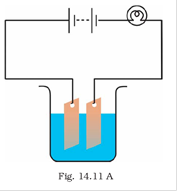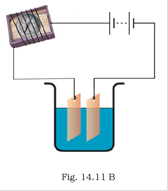Observing that the bulb does not glow in the circuit shown in Fig. 14.11 A, Boojho changed the circuit as shown in Fig 14.11 B. He observed deflection in the magnetic compass.


(i) What does the deflection in magnetic compass indicate?
(ii) Why did the bulb not glow in Fig.14.11 A?
(iii) What would be the effect of increase in the number of turns in the coil wound around the magnetic compass in Fig. 14.11B?
(iv) What will be observed if the number of cells are increased in the circuit shown in Fig. 14.11B?
(i)The defection in the magnetic compass indicates that current is flowing through the circuit. The compass needle deflects due to magnetic effect produced by the current.
(ii) the bulb did not glow in circuit A because the current passing through circuit is weak. if the current through the circuit is weak, the filament of the bulb does not get heated sufficiently and it does not glow. This indicates the solution is weak conductor of electricity.
(iii) when we increase the number of turns in the coil wound around the magnetic compass, the magnetic field produced due to current through the circuit increases and deflection in the needle in the compass increases.
(iv) increase in number of cells would increase the voltage across the circuit and would increase the current flowing through circuit. This will result in more increase in deflection of needle in magnetic compass.